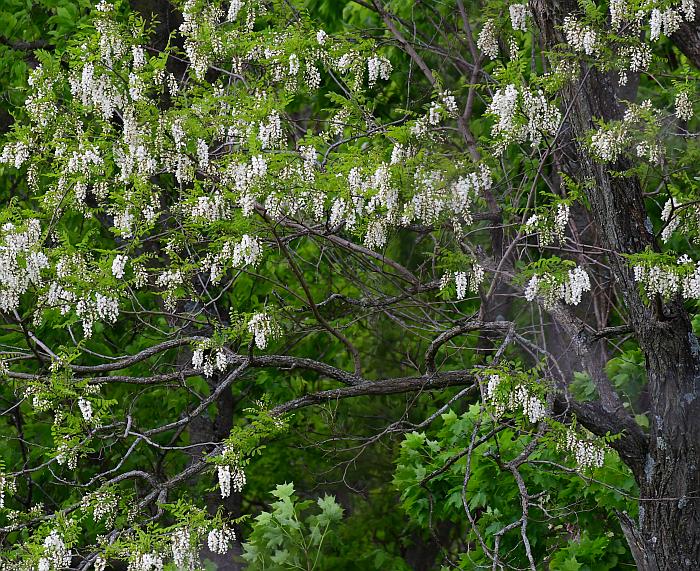Robinia pseudoacacia L.
Black Locust

Native
CC =
CW = 3
MOC = 50
© SRTurner
Robinia pseudoacacia L.Black Locust | |
 |
Native CC = CW = 3 MOC = 50 |
© SRTurner |
|
Family - Fabaceae/Faboideae Habit - Trees to 15 m or more tall, root suckering and often colonial. Stems - Woody, single, to 15 m. Twigs sparsely and minutely hairy when young, not bristly, becoming glabrous or nearly so with age. Paired spines present on younger branches.
Leaves - Alternate, odd-pinnate, typically with 11-19 leaflets, the petioles 2-3 cm long, the rachis 10-25 cm long, sparsely to moderately pubescent with minute, soft, curved hairs. Stipules initially 3-4 mm long, linear, and soft, but often becoming modified into slender to stout spines 5-10 mm long. Leaflets 3-7 cm long, 1.5-3.0 cm wide, ovate to elliptic, the surfaces glabrous or nearly so.
Inflorescence - Drooping Axillary racemes to 15 cm long, typically with 10-35 flowers, the stalk and axis moderately to densely pubescent with minute curved and often velvety hairs, not bristly. Flowers with the stalk 5-10 mm long.
Flowers - Calyces with the tube 3-5 mm long, densely short-hairy, the lobes 1-3 mm long, angled or short-tapered to a usually sharply pointed tip. Corollas papilionaceous, white, the banner 20-25 mm long, with a yellow spot toward the base, the wings 15-22 mm long, 4-6 mm wide, the keel 15-22 mm long, 4-7 mm wide. Stamens diadelphous, tube to 1.4 cm long. Filaments 14-18 mm long. Anthers orange, 1 mm long. Ovary 9-12 mm long, the style 7-9 mm long, upcurving near apex.
Fruits - Legumes 5-11 cm long, 10-14 mm wide, strongly flattened, glabrous at maturity, 3-10-seeded. Seeds 5-6 mm long, 3.0-3.5 mm wide, kidney-shaped, the surface dark brown, often mottled with purplish brown, smooth.
Flowering - May - June. Habitat - Forests, streambanks, pond margins, bases and tops of bluffs, pastures, fencerows, mine tailings, roadsides, and disturbed areas. Origin - Native to the U.S. Lookalikes - Gleditsia triacanthos. Other info. - This tree is somewhat scattered in Missouri, common in eastern and southwestern counties of the state. It is found across most of the continental U.S. It is considered native in the eastern U.S., introduced elsewhere. Its native range is somewhat obscured due to being extensively spread by Native Americans and early settlers. The flowering tree is unmistakable, with hanging inflorescences of large, white flowers of the legume pattern. Photographs taken in Columbia, MO., 2-21-04 and 5-11-04 (DETenaglia); also near Labadie, Franklin County, MO, 5-3-2015 and 4-29-2023, and at Meramec State Park, Franklin County, MO, 5-7-2019 (SRTurner). |